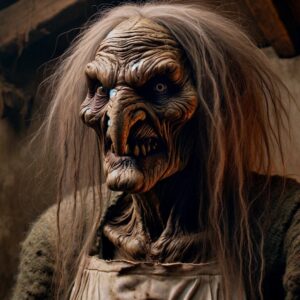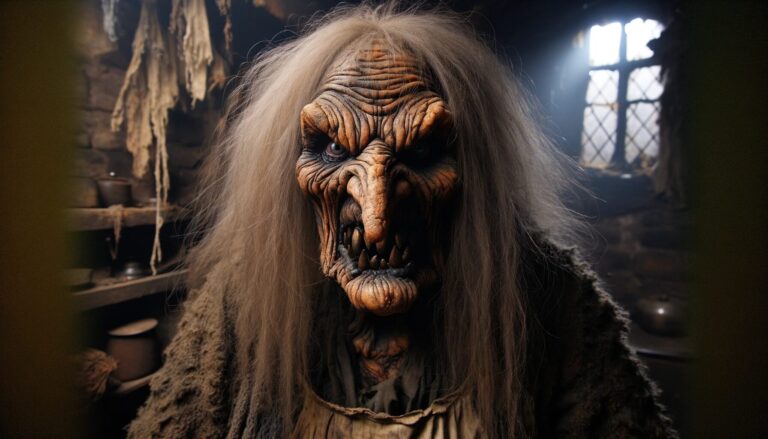Table of Contents
In the realm of Slavic folklore, the Babaroga stands as an enigmatic and fearsome figure. Furthermore, she is a creature steeped in mystery, often depicted as a monstrous witch or hag with a malevolent disposition. Additionally, the Babaroga’s origins are shrouded in the mists of time, and her presence in various Slavic cultures has given rise to a rich tapestry of myths, stories, and superstitions.
Origins
The Babaroga’s origins are deeply rooted in Slavic folklore, with variations of her name and character found in various Slavic-speaking regions. The term “Babaroga” itself is believed to have Serbian and Croatian origins. In different Slavic languages, she is known by various names, such as “Baba Roga” in Russian and “Baba Yaga” in certain Slavic cultures. These variations of her name hint at the complex nature of her character and her widespread presence in Slavic mythology.
Family Ties and Relationships
The Babaroga’s familial connections in folklore are somewhat elusive, and they vary from one tale to another. In some legends, she is portrayed as a solitary and malevolent witch, dwelling deep in the forest or swamp, far from human civilization. In other stories, she is said to be related to the more well-known character, Baba Yaga, who is also a fearsome witch in Slavic folklore. These familial connections add an intriguing layer to the Babaroga’s character, sparking curiosity about her true origins.
Appearance

The Babaroga is often described as a grotesque and horrifying figure. Moreover, she is typically depicted as an elderly woman with haggard features and long, unkempt hair that hangs in tangled masses. Additionally, her skin is said to be leathery and wrinkled, resembling the bark of an ancient tree. One of her most distinctive features is her iron-like nose, which she uses to sniff out children who have misbehaved or strayed too far from home.
The Babaroga is usually depicted wearing a tattered and dirty apron, symbolizing her role as a household witch. Additionally, in some versions of the myth, she is said to have iron teeth, which she uses to devour disobedient children. Consequently, her fearsome appearance is designed to strike terror into the hearts of those who encounter her, making her an effective cautionary figure in Slavic folklore.
Abilities and Powers
The Babaroga possesses a range of supernatural abilities and powers that make her a formidable figure in Slavic mythology. These powers vary in different stories but often include the following:
- Shape-Shifting. The Babaroga can change her appearance at will, allowing her to assume the guise of an innocent and trusted individual. This ability makes it easier for her to approach her victims undetected.
- Invisibility: In some legends, the Babaroga can render herself invisible, further enhancing her ability to move stealthily and avoid detection.
- Control Over Nature: The Babaroga is believed to have command over the forces of nature, particularly the weather. She can conjure storms, fog, and darkness to create an eerie and foreboding atmosphere in her surroundings.
- Kidnapping Children. Perhaps the most well-known aspect of the Babaroga’s abilities is her penchant for kidnapping children who misbehave or disobey their parents. She is said to lure them away from their homes or playmates and take them to her lair, where their fate is often grim.
- Curses and Hexes. Like many witches in folklore, the Babaroga is capable of casting curses and hexes upon those who cross her path. These curses can bring misfortune, illness, or even death to their victims.
Symbols
In Slavic folklore, symbols are often used to represent mythical creatures and entities, including the Babaroga. While the Babaroga herself may not have as many distinct symbols as some other mythical beings, there are several elements and motifs associated with her that serve as symbols:
- Iron Nose: The iron-like nose of the Babaroga is a significant symbol representing her ability to sniff out misbehaving children. It serves as a warning to children to behave and stay close to home, lest they attract her attention.
- Witch’s Broom. The Babaroga is often depicted with a witch’s broom, a traditional symbol of witches and their association with magic and the supernatural.
- Cauldron. Like many witches, the Babaroga is sometimes depicted with a cauldron, which symbolizes her role as a practitioner of dark magic.
- Black Cat: In some variations of the Babaroga myth, she is said to have a black cat as a companion. Black cats have long been associated with superstitions and folklore surrounding witches.
Myths and Stories

The Babaroga appears in numerous myths and stories throughout Slavic folklore. These tales serve as cautionary tales for children, warning them of the consequences of disobedience and misbehavior. Here are a few notable myths and stories featuring the Babaroga:
The Lost Children
Once upon a time, in a remote village nestled deep within the forest. There lived a notorious and fearsome creature known as the Babaroga. This malevolent entity was infamous for her penchant for mischief, especially when it came to children. In one popular story, her dark reputation took center stage.
Two young children, siblings named Mila and Marko, had strayed too far from their village while playing near the edge of the woods. Unbeknownst to them, the Babaroga had been watching and seized the opportunity to pounce. With swift and stealthy movements, she captured the unsuspecting children and spirited them away to her hidden lair deep within the forest.
At the heart of the forest, the lost children found themselves in a dimly lit cavern, their hearts heavy with fear. However, they were determined to escape the clutches of the Babaroga and find their way back home. Albeit terrified, they knew that their wits would be their most valuable allies in this dire situation.
As the night fell, Mila and Marko observed the Babaroga’s peculiar habits and weaknesses. When the Babaroga finally drifted into slumber, they seized their chance and executed a daring escape, navigating the labyrinthine forest with the skills they had acquired from their adventures.
Although they encountered numerous obstacles, the resourceful siblings persisted, finding their way back to their village guided by the North Star. The villagers welcomed them with open arms, and the legend of Mila and Marko’s bravery in outsmarting the fearsome Babaroga echoed through the ages.
The Babaroga’s Bargain
In a small, remote village nestled deep within the forest, a mother named Ivana faced a dire predicament. Her young daughter, Ana, was gravely ill, and despite the efforts of the village healers, her condition only worsened. Desperate and with no other recourse, Ivana turned to the only one rumored to possess dark and mysterious powers—the Babaroga.
With trepidation, Ivana journeyed to the outskirts of the village, where the Babaroga resided in a decrepit cottage. The Babaroga, her iron-like nose and tattered apron lending her an eerie air, listened to Ivana’s plea. In exchange for her help, she demanded Ivana’s soul, a sinister undertone lacing her voice.
Reluctantly, Ivana agreed, fully aware of the grave consequences of such a pact. The Babaroga conjured potions and chanted incantations, eventually curing Ana’s ailment. However, as Ana’s health returned, Ivana began to wither, her vitality draining away.
While the villagers rejoiced at Ana’s recovery, they remained oblivious to the terrible cost of the deal. Ivana, frail and hollow, realized the price for her daughter’s life—her soul forever bound to the Babaroga. The story cautions about deals with dark forces.
Baba Roga and Baba Yaga

In the heart of the mystical forest, Baba Yaga and the Babaroga detected a disquieting disturbance that stirred the very essence of magic. Accordingly, setting aside their longstanding rivalry, they converged at the source, where their presence caused an electric tension in the air.
Baba Yaga, with her wild hair and iron teeth gleaming, greeted the Babaroga with a wry smile. In turn, the Babaroga, undeterred by Baba Yaga’s fearsome reputation, returned the smile with a respectful nod. Additionally, this unspoken acknowledgment of each other’s power marked the start of an unlikely alliance.
Their joint investigation unveiled a malevolent force, a perilous threat to the forest and the delicate balance of magic in the realm. Consequently, recognizing the gravity of the situation, Baba Yaga and the Babaroga combined their unique talents and knowledge. Baba Yaga brewed a potent concoction to weaken the malevolent force, while the Babaroga employed her uncanny ability to locate and lure the source.
Together, they set a cunning trap, ensnaring the malevolent entity in a climactic battle beneath the towering trees. Consequently, with their combined powers, they overcame the darkness, banishing it from the forest and restoring peace to the enchanted woods.
As the dust settled, Baba Yaga and the Babaroga stood side by side. As a result, their rivalry transformed into a powerful alliance born from necessity.
Similarities
Baba Yaga (Slavic folklore): Baba Yaga is another prominent witch-like figure in Slavic folklore. She is known for her frightening appearance, living in a hut on chicken legs, and her habit of kidnapping children.
La Llorona (Mexican and Latin American folklore). La Llorona, or “The Weeping Woman,” is a ghostly figure who roams rivers and lakes, mourning her lost children. She is often depicted as a woman in white who kidnaps children or warns them to behave.
Krampus (Central European folklore): Krampus is a horned, demonic creature who accompanies St. Nicholas in some European traditions. He punishes naughty children during the Christmas season, contrasting with St. Nicholas, who rewards well-behaved ones.
Lamia (Greek mythology): Lamia is a female demon who lures and devours children. She is often depicted as a beautiful woman who conceals her true nature.
FAQ
What does Babaroga do?
Babaroga is believed to abduct misbehaving children, and she is often used by parents to warn their kids to behave.
What does Babaroga look like?
Her appearance varies in different versions of the folklore, but she is usually depicted as an old, haggard woman with frightening features.
Is Babaroga a well-known character?
Yes, Babaroga is a well-known character in the folklore of several Eastern European countries, such as Serbia, Croatia, and Slovenia.
Is there a moral to Babaroga stories?
Yes, Babaroga stories often serve as cautionary tales, teaching children about the consequences of misbehavior and disobedience.




